University Finance Module: Management Accounting Assignment Analysis
VerifiedAdded on 2019/11/26
|7
|930
|313
Homework Assignment
AI Summary
This assignment provides a comprehensive analysis of management accounting principles, specifically focusing on costing systems. The solution begins with a detailed calculation of manufacturing costs using traditional costing methods, comparing costs for two different production scenarios (FREDs and MARTHAs). It explores the calculation of direct materials, direct labor, and various manufacturing overhead costs. The assignment then delves into activity-based costing (ABC), outlining the cost drivers and budgeted levels for different activities. The solution includes a comparative analysis of the two costing systems, highlighting the differences in cost allocation and the impact on cost per unit. Furthermore, it discusses the advantages and disadvantages of both traditional and ABC costing methods, emphasizing the accuracy and decision-making implications of each approach. Finally, the solution provides a discussion of the benefits and drawbacks of using ABC costing systems, providing a well-rounded understanding of the topic.
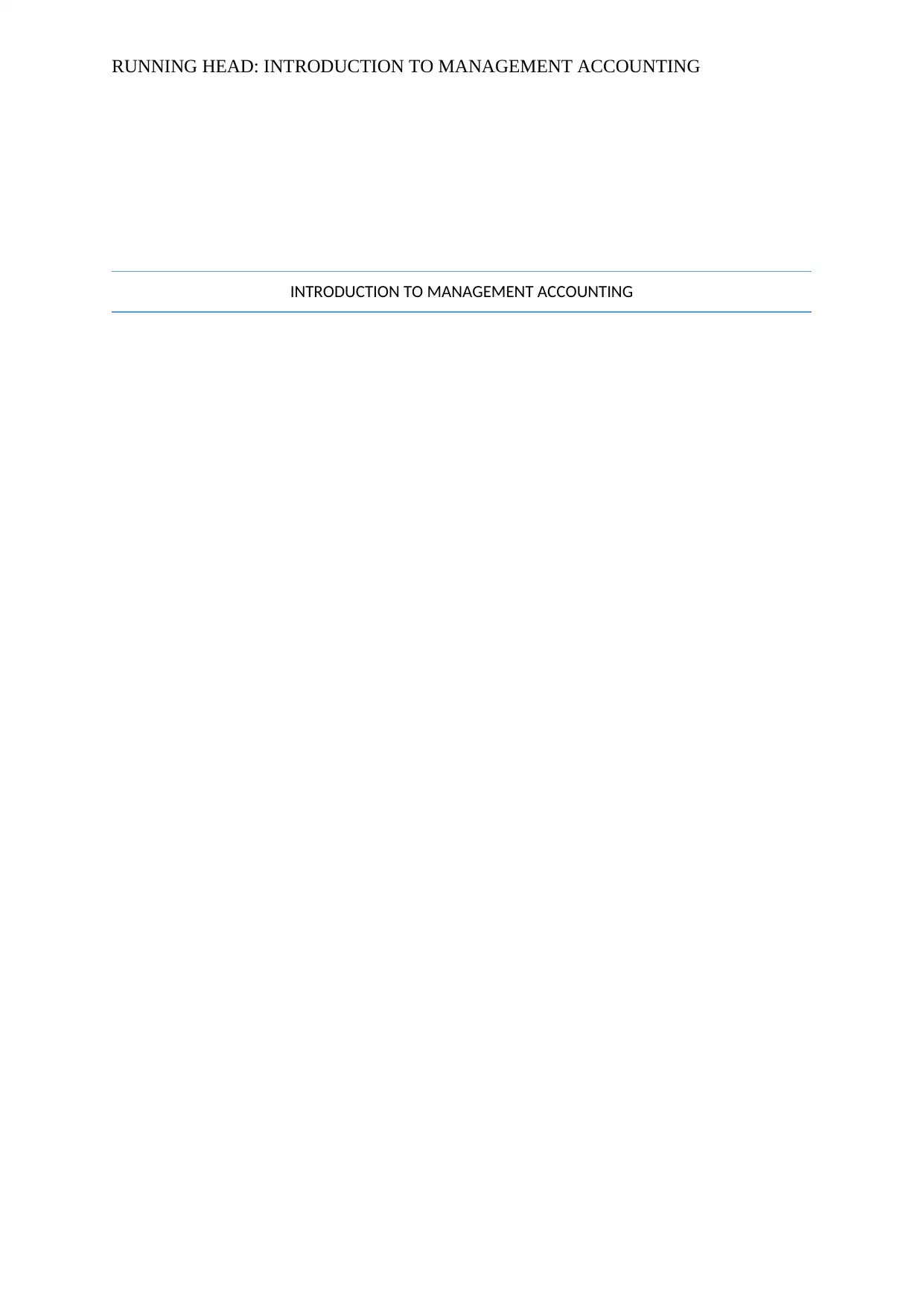
RUNNING HEAD: INTRODUCTION TO MANAGEMENT ACCOUNTING
INTRODUCTION TO MANAGEMENT ACCOUNTING
INTRODUCTION TO MANAGEMENT ACCOUNTING
Paraphrase This Document
Need a fresh take? Get an instant paraphrase of this document with our AI Paraphraser
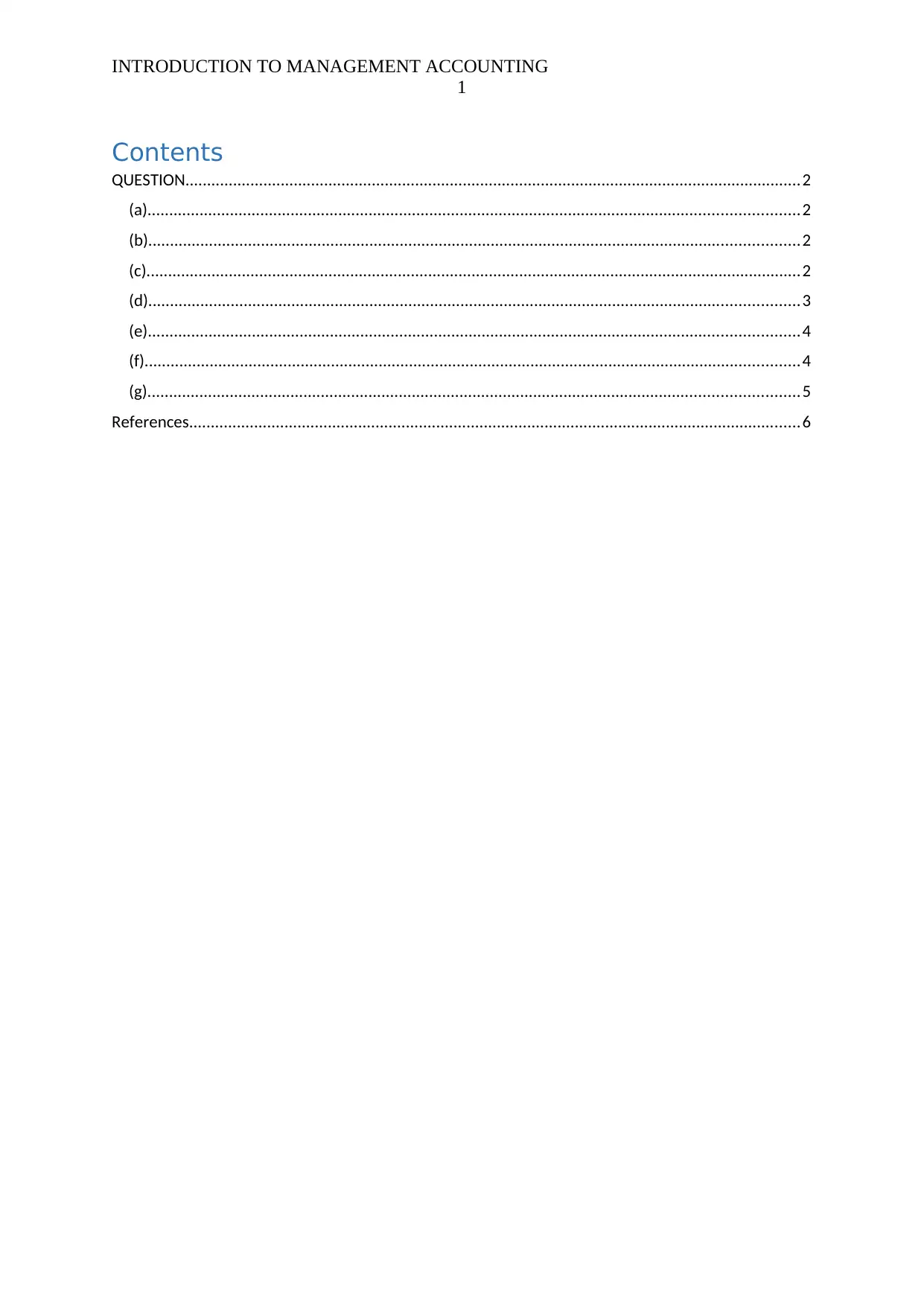
INTRODUCTION TO MANAGEMENT ACCOUNTING
1
Contents
QUESTION..............................................................................................................................................2
(a)......................................................................................................................................................2
(b)......................................................................................................................................................2
(c).......................................................................................................................................................2
(d)......................................................................................................................................................3
(e)......................................................................................................................................................4
(f).......................................................................................................................................................4
(g)......................................................................................................................................................5
References.............................................................................................................................................6
1
Contents
QUESTION..............................................................................................................................................2
(a)......................................................................................................................................................2
(b)......................................................................................................................................................2
(c).......................................................................................................................................................2
(d)......................................................................................................................................................3
(e)......................................................................................................................................................4
(f).......................................................................................................................................................4
(g)......................................................................................................................................................5
References.............................................................................................................................................6
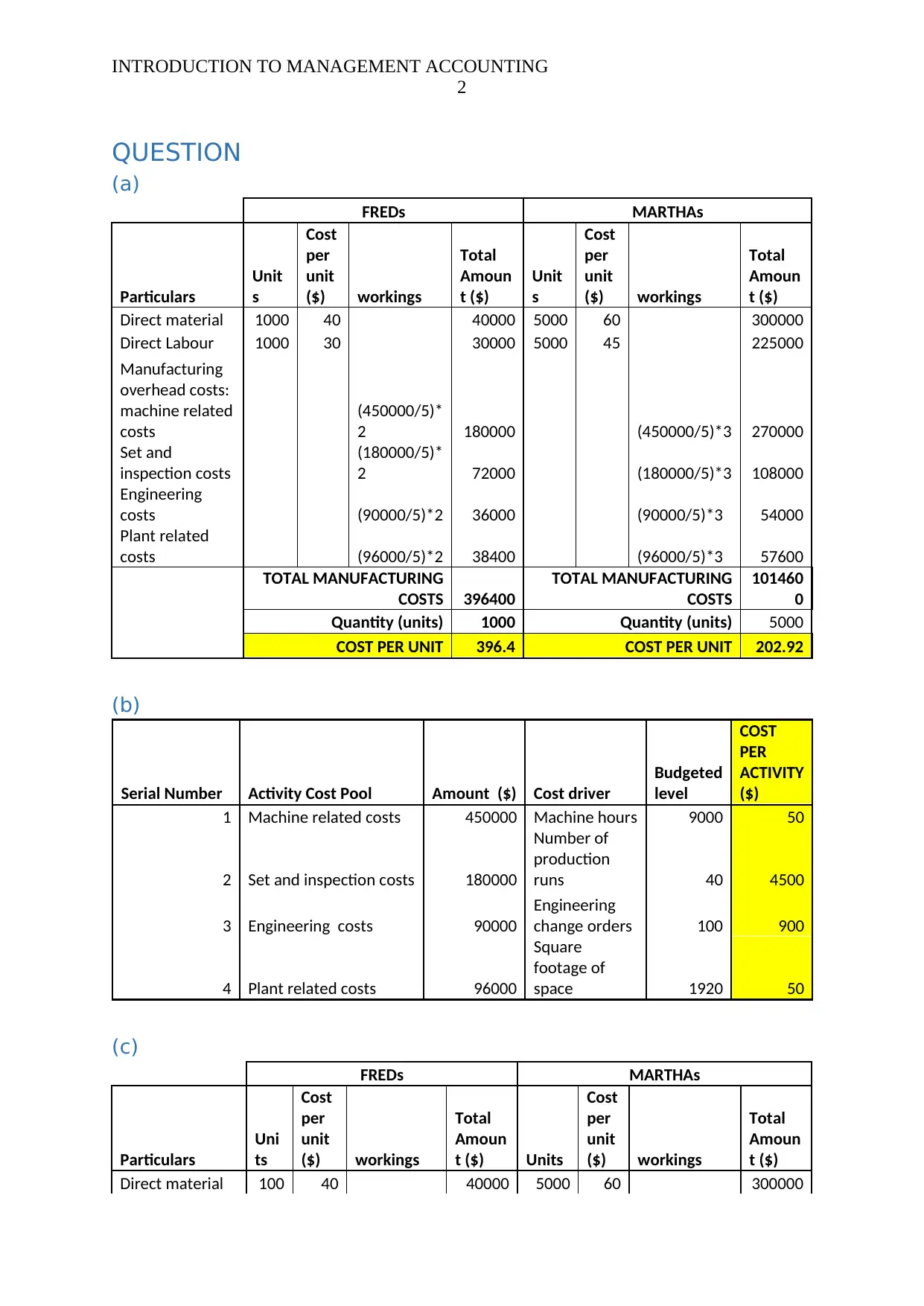
INTRODUCTION TO MANAGEMENT ACCOUNTING
2
QUESTION
(a)
FREDs MARTHAs
Particulars
Unit
s
Cost
per
unit
($) workings
Total
Amoun
t ($)
Unit
s
Cost
per
unit
($) workings
Total
Amoun
t ($)
Direct material 1000 40 40000 5000 60 300000
Direct Labour 1000 30 30000 5000 45 225000
Manufacturing
overhead costs:
machine related
costs
(450000/5)*
2 180000 (450000/5)*3 270000
Set and
inspection costs
(180000/5)*
2 72000 (180000/5)*3 108000
Engineering
costs (90000/5)*2 36000 (90000/5)*3 54000
Plant related
costs (96000/5)*2 38400 (96000/5)*3 57600
TOTAL MANUFACTURING
COSTS 396400
TOTAL MANUFACTURING
COSTS
101460
0
Quantity (units) 1000 Quantity (units) 5000
COST PER UNIT 396.4 COST PER UNIT 202.92
(b)
Serial Number Activity Cost Pool Amount ($) Cost driver
Budgeted
level
COST
PER
ACTIVITY
($)
1 Machine related costs 450000 Machine hours 9000 50
2 Set and inspection costs 180000
Number of
production
runs 40 4500
3 Engineering costs 90000
Engineering
change orders 100 900
4 Plant related costs 96000
Square
footage of
space 1920 50
(c)
FREDs MARTHAs
Particulars
Uni
ts
Cost
per
unit
($) workings
Total
Amoun
t ($) Units
Cost
per
unit
($) workings
Total
Amoun
t ($)
Direct material 100 40 40000 5000 60 300000
2
QUESTION
(a)
FREDs MARTHAs
Particulars
Unit
s
Cost
per
unit
($) workings
Total
Amoun
t ($)
Unit
s
Cost
per
unit
($) workings
Total
Amoun
t ($)
Direct material 1000 40 40000 5000 60 300000
Direct Labour 1000 30 30000 5000 45 225000
Manufacturing
overhead costs:
machine related
costs
(450000/5)*
2 180000 (450000/5)*3 270000
Set and
inspection costs
(180000/5)*
2 72000 (180000/5)*3 108000
Engineering
costs (90000/5)*2 36000 (90000/5)*3 54000
Plant related
costs (96000/5)*2 38400 (96000/5)*3 57600
TOTAL MANUFACTURING
COSTS 396400
TOTAL MANUFACTURING
COSTS
101460
0
Quantity (units) 1000 Quantity (units) 5000
COST PER UNIT 396.4 COST PER UNIT 202.92
(b)
Serial Number Activity Cost Pool Amount ($) Cost driver
Budgeted
level
COST
PER
ACTIVITY
($)
1 Machine related costs 450000 Machine hours 9000 50
2 Set and inspection costs 180000
Number of
production
runs 40 4500
3 Engineering costs 90000
Engineering
change orders 100 900
4 Plant related costs 96000
Square
footage of
space 1920 50
(c)
FREDs MARTHAs
Particulars
Uni
ts
Cost
per
unit
($) workings
Total
Amoun
t ($) Units
Cost
per
unit
($) workings
Total
Amoun
t ($)
Direct material 100 40 40000 5000 60 300000
⊘ This is a preview!⊘
Do you want full access?
Subscribe today to unlock all pages.

Trusted by 1+ million students worldwide

INTRODUCTION TO MANAGEMENT ACCOUNTING
3
0
Direct Labour
100
0 30 30000 5000 45 225000
Manufacturing
overhead costs:
machine related
costs
(50*1000*4
) 200000 (50*5000*1) 250000
Set and
inspection costs
(4500*1000
*/50) 90000
(4500*5000/
250) 90000
Engineering
costs
(900*100*3
/4) 67500
(900*100*1/
4) 22500
Plant related
costs
(50*1920*8
0%) 76800
(50*1920*20
%) 19200
TOTAL MANUFACTURING
COSTS 504300
TOTAL MANUFACTURING
COSTS 906700
Quantity (units) 1000 Quantity (units) 5000
MANUFACTURING COST
PER UNIT 504.3
MANUFACTURING COST PER
UNIT 181.34
(d)
FREDs MARTHAs
Particulars
Unit
s
Cost
per
unit
($) workings
Total
Amou
nt ($)
Uni
ts
Cost
per
unit
($) workings
Total
Amou
nt ($)
Direct material 1000 40 40000
500
0 60
30000
0
Direct Labour 1000 30 30000
500
0 45
22500
0
Manufacturing
overhead costs:
machine related
costs (50*1000*4)
20000
0 (50*5000*1)
25000
0
Set and inspection
costs
(4500*1000*
/50) 90000
(4500*5000/2
50) 90000
Engineering costs
(900*100*3/
4) 67500 (900*100*1/4) 22500
Plant related costs
(50*1920*80
%) 76800
(50*1920*20%
) 19200
TOTAL MANUFACTURING
COSTS
50430
0
TOTAL MANUFACTURING
COSTS
90670
0
Quantity (units) 1000 Quantity (units) 5000
MANUFACTURING COST
PER UNIT 504.3
MANUFACTURING COST
PER UNIT
181.3
4
Add: Margin 120% of cost
per unit
605.1
6
Add: Margin 120% of cost
per unit
217.6
08
3
0
Direct Labour
100
0 30 30000 5000 45 225000
Manufacturing
overhead costs:
machine related
costs
(50*1000*4
) 200000 (50*5000*1) 250000
Set and
inspection costs
(4500*1000
*/50) 90000
(4500*5000/
250) 90000
Engineering
costs
(900*100*3
/4) 67500
(900*100*1/
4) 22500
Plant related
costs
(50*1920*8
0%) 76800
(50*1920*20
%) 19200
TOTAL MANUFACTURING
COSTS 504300
TOTAL MANUFACTURING
COSTS 906700
Quantity (units) 1000 Quantity (units) 5000
MANUFACTURING COST
PER UNIT 504.3
MANUFACTURING COST PER
UNIT 181.34
(d)
FREDs MARTHAs
Particulars
Unit
s
Cost
per
unit
($) workings
Total
Amou
nt ($)
Uni
ts
Cost
per
unit
($) workings
Total
Amou
nt ($)
Direct material 1000 40 40000
500
0 60
30000
0
Direct Labour 1000 30 30000
500
0 45
22500
0
Manufacturing
overhead costs:
machine related
costs (50*1000*4)
20000
0 (50*5000*1)
25000
0
Set and inspection
costs
(4500*1000*
/50) 90000
(4500*5000/2
50) 90000
Engineering costs
(900*100*3/
4) 67500 (900*100*1/4) 22500
Plant related costs
(50*1920*80
%) 76800
(50*1920*20%
) 19200
TOTAL MANUFACTURING
COSTS
50430
0
TOTAL MANUFACTURING
COSTS
90670
0
Quantity (units) 1000 Quantity (units) 5000
MANUFACTURING COST
PER UNIT 504.3
MANUFACTURING COST
PER UNIT
181.3
4
Add: Margin 120% of cost
per unit
605.1
6
Add: Margin 120% of cost
per unit
217.6
08
Paraphrase This Document
Need a fresh take? Get an instant paraphrase of this document with our AI Paraphraser

INTRODUCTION TO MANAGEMENT ACCOUNTING
4
SALE PRICE
1109.
46 SALE PRICE
398.9
48
(e)
There are two cost systems which includes traditional costing system and Activity
based costing used in today’s environment. Earlier, the companies used traditional costing
technique where the overhead costs are apportioned only on few bases such as direct labour
hours, direct machine hours, direct material hours etc. which is quiet straight forward and
time saving. In traditional costing technique, manufacturing costs are allocated to the product
and ignores to apportioned the non-manufacturing costs (Example: Administrative expenses,
managerial costs etc.) which are also related to the product which leads to mispricing the
products (Traditional costing vs. Activity based costing, 2017).
In this question, cost per unit as per traditional costing technique is computed (above
‘a’), manufacturing overhead costs are computed as per direct labour hours. Allocating costs
as per direct labour hours is not the considered as best cost driver. Moreover, conventional
costing approach leads to poor decision making.
(f)
Activity Based Costing (ABC) is one of the common cost system used by many
companies in today’s scenario. This system considers all the activities of manufacturing
which are incurred on the production process of a specific product.
Benefits of ABC costing system:
Greater amount of accuracy in the costing because it apportions costs to the products
which require production activities ((Traditional costing vs. Activity based costing,
2017).
Another benefit is that it eliminates the immaterial costs to the product.
4
SALE PRICE
1109.
46 SALE PRICE
398.9
48
(e)
There are two cost systems which includes traditional costing system and Activity
based costing used in today’s environment. Earlier, the companies used traditional costing
technique where the overhead costs are apportioned only on few bases such as direct labour
hours, direct machine hours, direct material hours etc. which is quiet straight forward and
time saving. In traditional costing technique, manufacturing costs are allocated to the product
and ignores to apportioned the non-manufacturing costs (Example: Administrative expenses,
managerial costs etc.) which are also related to the product which leads to mispricing the
products (Traditional costing vs. Activity based costing, 2017).
In this question, cost per unit as per traditional costing technique is computed (above
‘a’), manufacturing overhead costs are computed as per direct labour hours. Allocating costs
as per direct labour hours is not the considered as best cost driver. Moreover, conventional
costing approach leads to poor decision making.
(f)
Activity Based Costing (ABC) is one of the common cost system used by many
companies in today’s scenario. This system considers all the activities of manufacturing
which are incurred on the production process of a specific product.
Benefits of ABC costing system:
Greater amount of accuracy in the costing because it apportions costs to the products
which require production activities ((Traditional costing vs. Activity based costing,
2017).
Another benefit is that it eliminates the immaterial costs to the product.
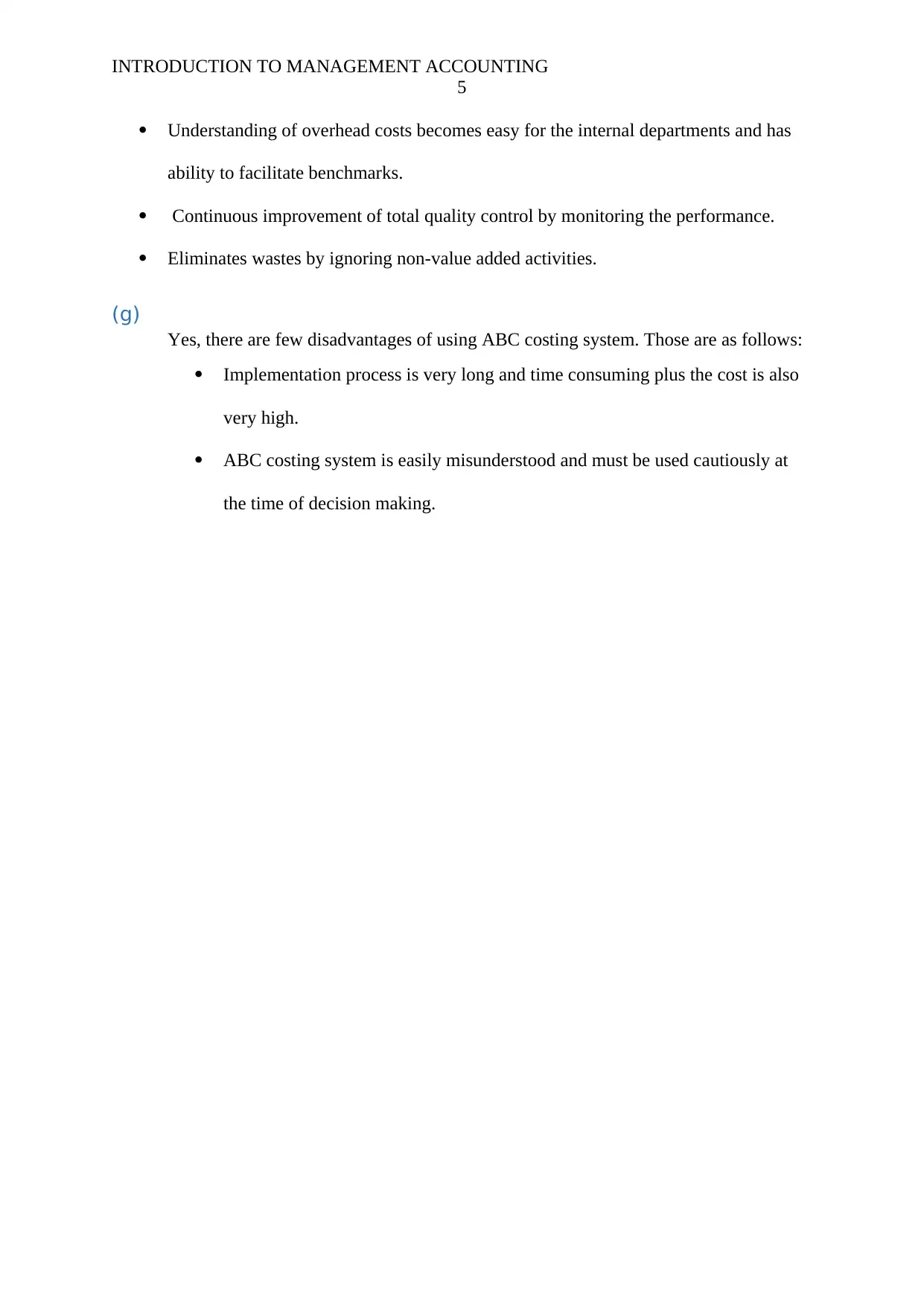
INTRODUCTION TO MANAGEMENT ACCOUNTING
5
Understanding of overhead costs becomes easy for the internal departments and has
ability to facilitate benchmarks.
Continuous improvement of total quality control by monitoring the performance.
Eliminates wastes by ignoring non-value added activities.
(g)
Yes, there are few disadvantages of using ABC costing system. Those are as follows:
Implementation process is very long and time consuming plus the cost is also
very high.
ABC costing system is easily misunderstood and must be used cautiously at
the time of decision making.
5
Understanding of overhead costs becomes easy for the internal departments and has
ability to facilitate benchmarks.
Continuous improvement of total quality control by monitoring the performance.
Eliminates wastes by ignoring non-value added activities.
(g)
Yes, there are few disadvantages of using ABC costing system. Those are as follows:
Implementation process is very long and time consuming plus the cost is also
very high.
ABC costing system is easily misunderstood and must be used cautiously at
the time of decision making.
⊘ This is a preview!⊘
Do you want full access?
Subscribe today to unlock all pages.

Trusted by 1+ million students worldwide
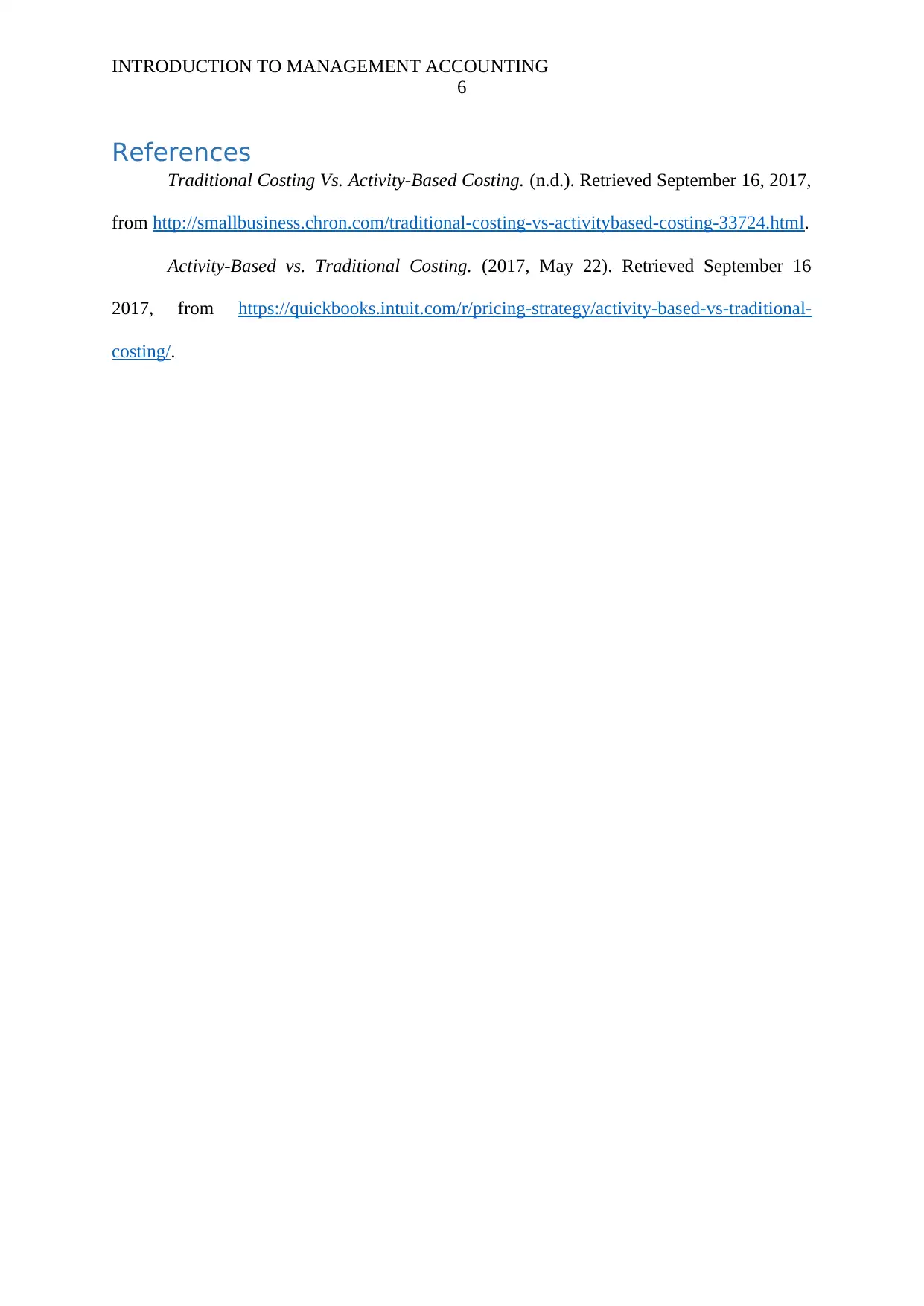
INTRODUCTION TO MANAGEMENT ACCOUNTING
6
References
Traditional Costing Vs. Activity-Based Costing. (n.d.). Retrieved September 16, 2017,
from http://smallbusiness.chron.com/traditional-costing-vs-activitybased-costing-33724.html.
Activity-Based vs. Traditional Costing. (2017, May 22). Retrieved September 16
2017, from https://quickbooks.intuit.com/r/pricing-strategy/activity-based-vs-traditional-
costing/.
6
References
Traditional Costing Vs. Activity-Based Costing. (n.d.). Retrieved September 16, 2017,
from http://smallbusiness.chron.com/traditional-costing-vs-activitybased-costing-33724.html.
Activity-Based vs. Traditional Costing. (2017, May 22). Retrieved September 16
2017, from https://quickbooks.intuit.com/r/pricing-strategy/activity-based-vs-traditional-
costing/.
1 out of 7
Related Documents
Your All-in-One AI-Powered Toolkit for Academic Success.
+13062052269
info@desklib.com
Available 24*7 on WhatsApp / Email
![[object Object]](/_next/static/media/star-bottom.7253800d.svg)
Unlock your academic potential
Copyright © 2020–2025 A2Z Services. All Rights Reserved. Developed and managed by ZUCOL.





